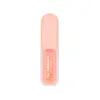What's inside
What's inside
 Key Ingredients
Key Ingredients

 Benefits
Benefits

 Concerns
Concerns

 Ingredients Side-by-side
Ingredients Side-by-side

Polybutene
Hydrogenated Polyisobutene
EmollientDiisostearyl Malate
EmollientOctyldodecanol
EmollientCera Alba
EmollientPhenyl Trimethicone
Skin ConditioningCyclopentasiloxane
EmollientDextrin Palmitate
EmulsifyingPentaerythrityl Tetraisostearate
EmollientPolyglyceryl-2 Triisostearate
EmulsifyingAscorbyl Tetraisopalmitate
AntioxidantCopernicia Cerifera Wax
Ethylhexyl Methoxycinnamate
UV AbsorberSynthetic Fluorphlogopite
Pyrus Malus Seed Oil
EmollientPhenoxyethanol
PreservativeEthylhexylglycerin
Skin ConditioningPolyhydroxystearic Acid
EmulsifyingTocopheryl Acetate
AntioxidantParfum
MaskingCyclotetrasiloxane
EmollientAluminum Hydroxide
EmollientTriethoxycaprylylsilane
Tocopherol
AntioxidantCI 77891
Cosmetic ColorantCI 77491
Cosmetic ColorantCI 77492
Cosmetic ColorantCI 77499
Cosmetic ColorantCI 15850
Cosmetic ColorantCI 45410
Cosmetic ColorantMica
Cosmetic ColorantPolybutene, Hydrogenated Polyisobutene, Diisostearyl Malate, Octyldodecanol, Cera Alba, Phenyl Trimethicone, Cyclopentasiloxane, Dextrin Palmitate, Pentaerythrityl Tetraisostearate, Polyglyceryl-2 Triisostearate, Ascorbyl Tetraisopalmitate, Copernicia Cerifera Wax, Ethylhexyl Methoxycinnamate, Synthetic Fluorphlogopite, Pyrus Malus Seed Oil, Phenoxyethanol, Ethylhexylglycerin, Polyhydroxystearic Acid, Tocopheryl Acetate, Parfum, Cyclotetrasiloxane, Aluminum Hydroxide, Triethoxycaprylylsilane, Tocopherol, CI 77891, CI 77491, CI 77492, CI 77499, CI 15850, CI 45410, Mica
Polyisobutene
Ethylhexyl Palmitate
Emollient3-O-Ethyl Ascorbic Acid
Skin ConditioningCetyl Ethylhexanoate
EmollientButyl Methoxydibenzoylmethane
UV AbsorberOctyldodecanol
EmollientDiisostearyl Malate
EmollientPrunus Amygdalus Dulcis Oil
Skin ConditioningHydrogenated Styrene/Isoprene Copolymer
Silica Dimethyl Silylate
EmollientCeramide NP
Skin ConditioningTocopherol
AntioxidantCamellia Japonica Seed Oil
EmollientVitis Vinifera Seed Oil
EmollientButyrospermum Parkii Butter
Skin ConditioningOctocrylene
UV AbsorberVanillyl Butyl Ether
MaskingParaffinum Liquidum
EmollientCI 15850
Cosmetic ColorantCI 77491
Cosmetic ColorantCI 15985
Cosmetic ColorantPolyisobutene, Ethylhexyl Palmitate, 3-O-Ethyl Ascorbic Acid, Cetyl Ethylhexanoate, Butyl Methoxydibenzoylmethane, Octyldodecanol, Diisostearyl Malate, Prunus Amygdalus Dulcis Oil, Hydrogenated Styrene/Isoprene Copolymer, Silica Dimethyl Silylate, Ceramide NP, Tocopherol, Camellia Japonica Seed Oil, Vitis Vinifera Seed Oil, Butyrospermum Parkii Butter, Octocrylene, Vanillyl Butyl Ether, Paraffinum Liquidum, CI 15850, CI 77491, CI 15985
Ingredients Explained
These ingredients are found in both products.
Ingredients higher up in an ingredient list are typically present in a larger amount.
Ci 15850 is the pigment color red. It is an azo dye and created synthetically.
Azo dyes need to be thoroughly purified before use. This allows them to be more stable and longer-lasting.
This ingredient is common in foundations, lipsticks, and blushes. This color is described as brown/orangey red.
It has many secondary names such as Red 6 and Red 7. According to a manufacturer, Red 6 usually contains aluminum.
Learn more about CI 15850Ci 77491 is also hydrated iron III oxide. It's sole purpose is to give a red/pink hue to products.
Iron III oxides are classified as inorganic chemicals for coloring.
Synthetically created Ci 77491 is considered safer than those naturally found. This is because the synthetically created version may contain less impurities. Iron oxides are generally non-toxic and non-allergenic.
Learn more about CI 77491Diisostearyl Malate is an emollient and most often used in lip products. It comes from isostearyl alcohol, a fatty acid, and malic acid, an AHA.
As an emollient, Diisostearyl Malate helps create a thin film on your skin to trap moisture in. This helps keep your skin soft and smooth.
Octyldodecanol is a fatty alcohol. It is primarily used to enhance the texture of products.
As an emulsifier, Octyldodecanol helps prevent the oils and waters from separating. It also prevents ingredients from creating foam when shaken.
Octyldodecanol is created by reducing fatty acid to an alcohol.
Due to its high molecular weight, it does not get absorbed into the skin.
Learn more about OctyldodecanolTocopherol (also known as Vitamin E) is a common antioxidant used to help protect the skin from free-radicals and strengthen the skin barrier. It's also fat soluble - this means our skin is great at absorbing it.
Vitamin E also helps keep your natural skin lipids healthy. Your lipid skin barrier naturally consists of lipids, ceramides, and fatty acids. Vitamin E offers extra protection for your skin’s lipid barrier, keeping your skin healthy and nourished.
Another benefit is a bit of UV protection. Vitamin E helps reduce the damage caused by UVB rays. (It should not replace your sunscreen). Combining it with Vitamin C can decrease sunburned cells and hyperpigmentation after UV exposure.
You might have noticed Vitamin E + C often paired together. This is because it is great at stabilizing Vitamin C. Using the two together helps increase the effectiveness of both ingredients.
There are often claims that Vitamin E can reduce/prevent scarring, but these claims haven't been confirmed by scientific research.
Learn more about Tocopherol